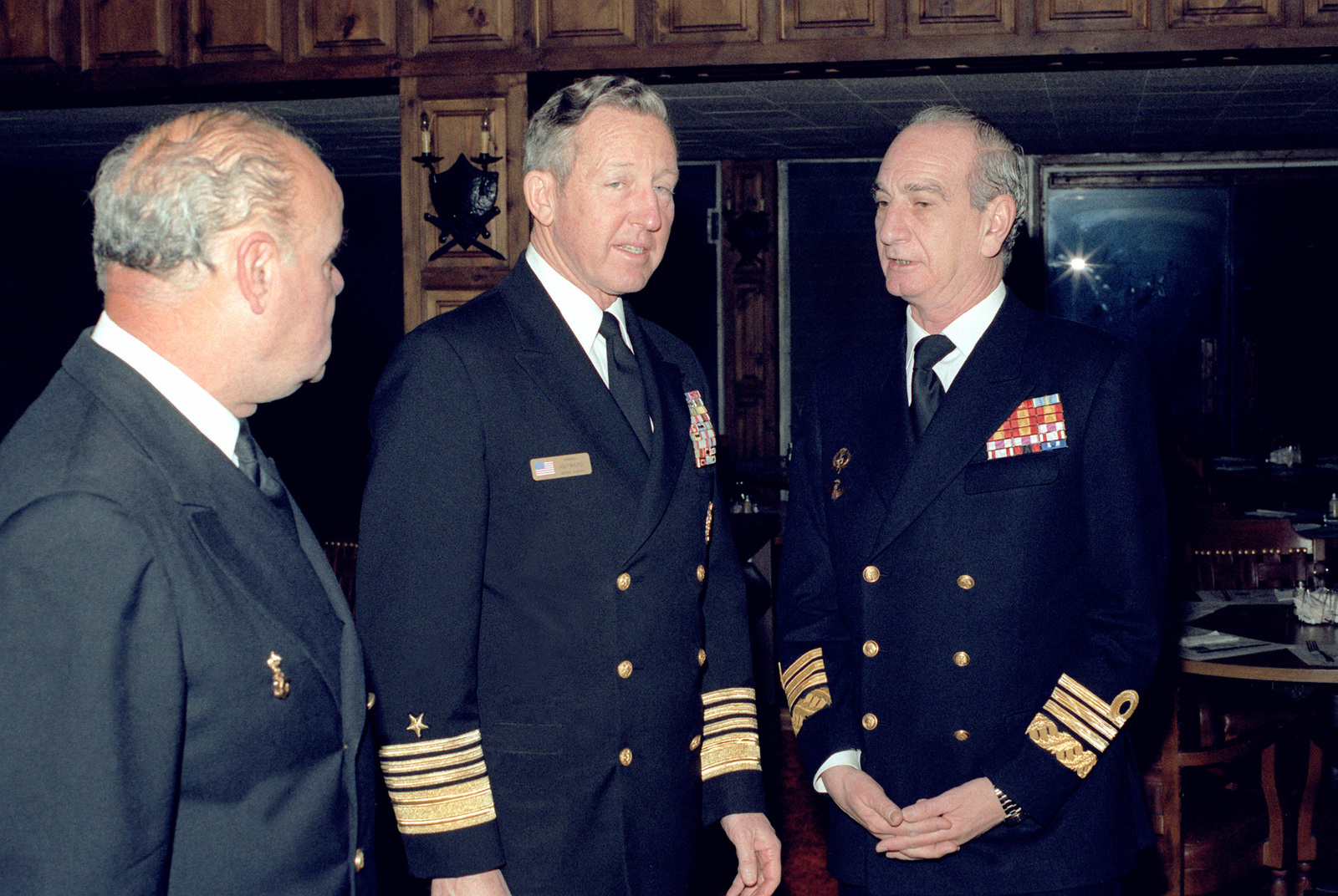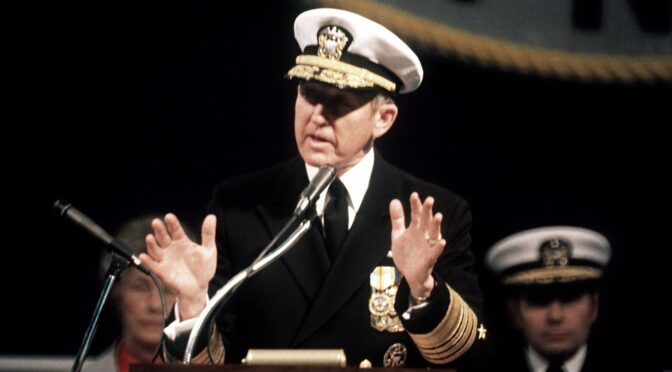By Sebastian Bruns
Admiral Thomas B. Hayward, United States Navy, passed away on March 3, 2022, just two months shy of his 98th birthday.
A week before and half a world away, on February 24, 2022, Russia began its long-anticipated, brutal, and illegal war against Ukraine, revealing to the whole world its true geopolitical intentions and character. Since the outbreak of the war, one of the trending terms was Zeitenwende, a German word for a sudden 180 degree turn in world history. One community that was less surprised by the eventual escalation is the international defense and foreign policy community. Since 2014, they have warned of the increasing likelihood of a new Cold War due to Vladimir Putin’s revisionist politics, and they saw the U.S. and NATO as woefully unprepared.
A part of that group are those gentlemen who presided over “The Maritime Strategy,” developed and refined in the 1980s to provide a prescription for seapower that helped defeat the Soviet Union and the Warsaw Pact. Many of these individuals were Lt. Commanders, Commanders, and Captains then and had considerable influence on writing, disseminating, exercising, and executing the strategy. Some of them consider “The Maritime Strategy” the gold standard of naval capstone documents, and they have often mentored those from succeeding generations of scholars and naval strategists accordingly. The U.S. Navy inadvertently buttressed that narrative by promulgating numerous strategies and strategy-minded documents instead of just one clearly defined and well-socialized product, which made the Navy’s strategic role confusing, diffuse, and ultimately erratic in the post-Cold War era.
The makers of “The Maritime Strategy” of the 1980s stood of course on the shoulders of giants. Consecutive Chiefs of Naval Operations — Admiral Elmo R. Zumwalt, Admiral James L. Holloway, and Admiral Thomas B. Hayward — walked so that others, namely their CNO successors Admiral James D. Watkins and Admiral Carlisle A.H. Trost and their strategists, could run.
Hayward was a naval aviator who was the 21st Chief of Naval Operations for the United States Navy from July 1, 1978 until June 30, 1982. Having held command of US Pacific Fleet, US 7th Fleet, and the carrier USS America (CVA-66) prior to rising to the top of the Navy, Hayward was acutely aware of the shortfalls of the “swing strategy” of the 1970s. Despite the massive Soviet naval buildup at the time, President Jimmy Carter’s administration early on proposed swinging naval forces – which were still quantitatively and qualitatively recovering from the Vietnam War – from the Pacific to the Atlantic or vice versa, when and where a crisis would mandate robust American naval presence. But Hayward had doubts about the viability of the strategy while serving as commander of Pacific Fleet. Hayward helped put into place “Sea Plan 2000” (1978), a classified book-length force planning study, while still on his Pacific tour. Hayward utilized his standing as a strategist which he had gathered in part through a series of briefings called “Sea Strike.” In a reflection last year on those developments, Adm. Hayward remarked:
“It became very clear to me that the Swing Strategy was the wrong answer. That’s when I formulated Sea Strike…The idea was that the strategy would take the fight to the Russians…I knew that what was already planned was definitely impractical. Send all our fleets to the Atlantic? Crazy idea.”
Understanding that a strategy could only be successful if carried out with thoughtful and up-to-date command relationships and sound tactics, he also fostered in the Pacific Fleet the development of the Composite Warfare Concept (CWC) for carrier battle groups and set up a new Tactical Training Group Pacific (TACTRAGRUPAC). Once he succeeded Holloway as CNO, he was therefore well placed to articulate three important capstone documents, all of which were published in 1979. Whereas the CNO Strategic Concepts was classified, the CNO Posture Statement was unclassified. Both were issued in January of 1979. Hayward’s article, “The Future of U.S. Sea Power,” which laid out unclassified fundamental principles, was published in May that year in Proceedings. Hayward therefore helped better position the U.S. Navy as a strategic asset in a year that saw the fall of the Shah, the Teheran Hostage Crisis, the Soviet intervention in Afghanistan, superpower détente, and the crumbling of Carter’s military and naval policies.
“The Future of Seapower” argued for maritime supremacy and a global, forward-deployed, and forward-present US Navy against the Soviet Union and the Warsaw Pact. The document called for allied contributions at a time where NATO was consolidating and U.S. allies around the world were in the process of modernizing their fleets. Its forward, global, and offensive posture was a marked departure from the security of the sea lines of communication that previous CNOs and President Carter had articulated. As Adm. Hayward wrote:
“An excellent starting point is a discussion of the U. S. requirement for ‘maritime superiority.’ I wish to emphasize this point of maritime superiority because it is a concept that has been given insufficient recognition in recent years, yet it is one which must form the basis for the planning of all our naval forces. It provides a clear and unambiguous yardstick against which to measure the adequacy of our naval forces—present and prospective. Its opposite is ‘maritime parity,’ or worse, ‘inferiority’—both of which are anathema to me, and which are wholly inconsistent with this country’s most essential national interests…I personally prefer the term ‘maritime supremacy’ to characterize the naval posture which our country’s interests require, as I believe it connotes a margin of superiority substantial enough to leave little doubt as to the likely outcome should U. S. naval forces be challenged.”
Hayward had degrees from the Naval War College, the National War College, and George Washington University. He was an experienced individual from the Navy program planning background. With this experience, he began to connect the dots inside and outside the Department of the Navy to not only consolidate and link strategic thinking, but also operational and tactical thought. Among other things, he encouraged the “Global War Game” held at the Naval War College and he created the CNO’s Strategic Studies Group (SSG). According to one research brief, the SSG’s objective was “to turn captains of ships into captains of war.” The SSG would go on to produce cohorts of naval strategists well-versed in the larger operational and strategic questions of major war at sea.

Hayward oversaw the establishment in the Atlantic Fleet of another tactically-focused command, Tactical Training Group Atlantic (TACTRAGRULANT). Moreover, Hayward emphasized material readiness and sailors’ health. Ever the tactician as well as strategist, in retirement he encouraged Captain Wayne Hughes to publish his seminal Fleet Tactics: Theory and Practice, for which he wrote the foreword. In emphasizing the fundamental importance of tactical excellence, in the foreword to Fleet Tactics he wrote:
“…we should guard against the insidious tendency to limit our tactical horizons to peacetime evolutions; we should instead seek to understand the ordeal of tomorrow’s technological war at sea, in all its ramifications. Regrettably, I would contend that we fall prey to the pressures of peacetime priorities, and thus over tactical excellence favor program management, system acquisition and…ship maintenance…it is risky and not in keeping with the lessons of history to permit tactical excellence to play second fiddle to any other needs, however essential. After all, what is the naval profession about, if not tactics, tactics, and more tactics?”
Hayward successfully expanded his Pacific thinking into a truly global outlook for the U.S. Navy – a mindset that seems to have atrophied in some circles of today’s Navy. It is no understatement that he gave the U.S. Navy a renewed sense of purpose that helped pave the way for the naval renaissance of the 1980s under President Ronald Reagan, Secretary of the Navy John Lehman, and their CNOs. Hayward’s roots helped “The Maritime Strategy” bloom, not least through continuity. His successor CNO James D. Watkins had been Hayward’s Vice CNO, and CNO Carlisle Trost had been his Director for Program Planning.
Before “The Maritime Strategy” was made public in 1986, there were numerous drafts and iterations, and Hayward had retired before the first secret version was issued in November of 1982. Notably, at the beginning of the decade, the world descended into what can be characterized as the “Second Cold War,” a dramatic superpower confrontation even under the circumstances of the U.S.-Soviet struggle. Short successions in Soviet leadership, unrest in Poland and the Eastern bloc, a plethora of events in 1983 – “the most dangerous year of the Cold War” – and NATO’s double-track decision demanded U.S. leadership and a global naval mindset.
Nearly four decades later, if war was really ever inevitable, if this is a new Cold War or a continuation of the last, that is for future historians to decide. But strategists should pause to consider the fundamental necessity of seapower, tactical excellence, and a global naval mindset in these trying times. The demand for naval strategy, operational art, tactics, and a strong capable Navy exists, but better managing the supply is critical.
Hayward would likely recommend getting to work now to expand the Navy, focus on combat readiness, and understand it as a truly global, offensive force. Hayward would likely suggest creating strategy, operations, and tactics through documents, strategic studies groups, war games, exercises, and through new operational patterns at sea, ideally complemented by a truly allied framework.
A U.S. Navy that is already extremely hard pressed will be pushed even harder in these coming months and years. For seapower advocates and naval strategists, there is no time to waste, and Adm. Hayward’s example shines a light forward.
Dr. Sebastian Bruns is McCain Fulbright Distinguished Visiting Professor at the U.S. Naval Academy in Annapolis, Md. and author of “US Naval Strategy and National Security. The Evolution of American Maritime Power,” (London: Routledge 2018).
Featured Image: ADM Thomas B. Hayward, chief of naval operations, speaks during the commissioning ceremony for the nuclear-powered aircraft carrier USS CARL VINSON (CVN-60) (Photo via U.S. National Archives)


I remember ADM Hayward as CNO very well. I once fell asleep during a briefing my boss was giving him. I was the guy with the slides. I had been up half the night developing the slides with a wonderful graphics specialist. I was exhausted the next morning at the briefing. The Admiral saw I was asleep but said “Let him sleep. I know how late he was up last night.” That’s leadership.
Over the past decade the USN has been trying decide what force structure is needed, often biased by the time and circumstances of the moment. The truth is it needs to become a projection of power at many levels. This has, as the article points out, confused the issue. Much attention is being paid to the potential world order of 2045. In my view that is too far out to be credible. We need multi-tiered thinking that includes the near, mid and far term. Sustainable, persistent and viable war making capabilities must create a different force structure, less dependent on the carrier navy and more agile along the graph of what is needed now. I am a proponent of smaller ships with higher levels of autonomy, smaller crews and more lethal weapons. See preceding articles regarding the Lightly Manned Autonomous Combat Capability (LMACC) for a more detailed argument.
I was on Admiral Hawards staff in1971 in Hawaii as a Navy LT. It was not long before all of us Junior Officers realized that we were working for a fast tracking officer who ultimately would wind up as CNO. I remember him as being genuine and personable and of course, an outstanding leader. I am deeply saddened by this LOSS.